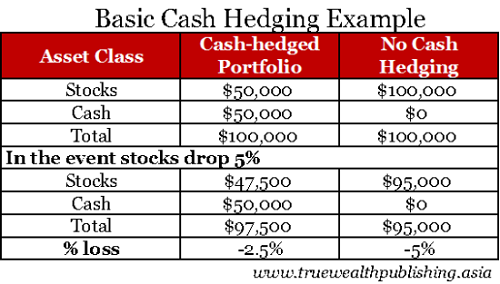Difference Between Hedging and Derivatives

Hedging Example
Hedging vs. Derivatives
Understanding both hedging and derivatives can give an enormous advantage to any investor.
Hedging is a technique or strategy that comes as a form of investment designed to avoid market volatility or to protect another investment or portfolio against potential investment risk or loss. Loss can be in the form of profit loss or risk loss. When it comes to profit loss, the hedging strategy safeguards the capital but fails to accumulate profits in the process when the risk didn’t happen. Meanwhile, a risk loss is what the hedging aims to protect against in the volatile and unpredictable financial market.
Hedging works and acts like an insurance because it serves as a preventive measure against negative or unexpected events such as risks and market situations.
There are two types of hedging: classical hedging and natural hedging. Classical hedging involves stocks and shares. In this type, the main goal is for the investor to balance the high-stakes share with the secured shares. The secure shares create the profit and act like a safety net for the loss, which is created by the high-stakes shares. On the other hand, unlike classic hedging, natural hedging doesn’t involve stocks and shares; instead, it involves many investment and managing techniques. It doesn’t involve instruments but strategy and the process.
In hedging, a variety of techniques are used. Among these techniques are: foreign exchange forwards, currency futures, debt, currency options, options trading, exchange-traded fund (ETF), and quant trading.
Hedging is not a guarantee against any kind of risk in the risk and return trade-off. Investors in hedge funds are also not covered by government protection, regulation, or oversight as personified by the SEC (Securities and Exchange Commission).

Derivatives, meanwhile, are a financial instrument used in hedging. Derivatives are basically contracts or agreements between two parties to buy or sell a certain asset. The asset can be decided to be bought and/or sold in the future with predetermined specifications.
Derivatives can take the form of options, futures, forwards, caps, floors, swaps, collars, and many others. All forms of derivatives can provide some sort of leverage and can be classified as either over-the-counter or exchange traded.
The two main types of derivatives are forwards and options. Forwards are agreements between two parties to buy or sell assets, while options contracts give the owners the right but not the duty to buy or sell the asset in the future. As the name implies, “options” are simply considerations to buy or sell at the pleasure of the owner.
In derivatives, there are underlying assets. Assets can be stocks, bonds, commodities, interest rates, or market indexes among others.
Summary:
1.Hedging and derivatives are related terms in the financial and investment world.
2.Hedging is an investment strategy and technique to prevent loss and risks in any market situation. It acts as a preventive measure – like insurance. Derivatives are just one of the hedging instruments.
3.In different situations, hedging can either result in a profit or a risk loss. Derivatives are tools that contribute to either result.
4.Both concepts are also different in nature. Hedging is a form of investment to protect another investment, while derivatives come in the form of contracts or agreements between two parties.
5.Hedging and extension derivatives are both unprotected or subject to regulation and oversight by the government.
6.Neither method is a sure way of protection or prevention losses or risks.
7.Another similarity is that hedging employs a lot of techniques. Derivatives also come in different forms. Classifications for both hedging and derivatives can be numerous in nature.
- Differences Between Fraternity And Sorority - January 8, 2014
- Differences Between Lucite and Plastic - January 7, 2014
- Differences Between Oil and Butter - January 6, 2014
Search DifferenceBetween.net :
Leave a Response
References :
[0]http://dollarsandsense.sg/5-1-ways-to-protect-your-portfolio-in-2017/
[1]http://www.blacklistednews.com/Derivatives_Market_%24280_Trillion_%E2%80%93_Is_It_Really_A_Time_Bomb%3F/40218/0/38/38/Y/M.html
